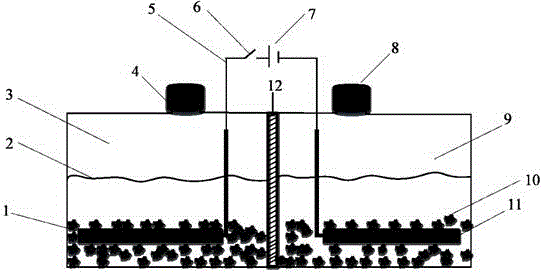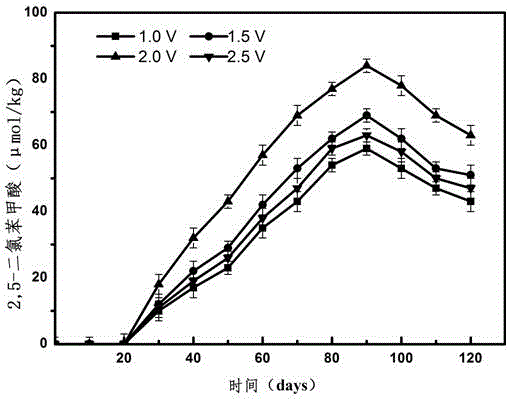Method and device for removing polychlorinated biphenyls (PCBs) in bottom mud through cathode anaerobism/anode aerobiosis coupling stimulated by micro electric field
A polychlorinated biphenyl and micro-electric field technology, applied in the restoration of polluted soil, etc., can solve the problems of strong dependence on environmental conditions, high cost, complicated operation, etc., to overcome the strong dependence on environmental conditions, realize the removal of pollutants, The effect of improving the degradation rate
- Summary
- Abstract
- Description
- Claims
- Application Information
AI Technical Summary
Problems solved by technology
Method used
Image
Examples
Embodiment 1
[0047] The present invention will be further described in detail below in conjunction with examples, but the embodiments of the present invention are not limited thereto. Example 1 A micro-electric field stimulation coupling cathodic anaerobic / anodic aerobic device used in this example to realize the removal of polychlorinated biphenyls in the sediment. The schematic diagram after inoculating the sediment 2 is as follows figure 1 As shown, it consists of an anode chamber 3 and a cathode chamber 9, which are separated by a cation exchange membrane 12. The liquid port 8 and the cathode electrode 11, the anode electrode 1 and the cathode electrode 11 are connected to the external circuit power supply 7 and the circuit switch 6 through the wire 5, and the anode chamber 3 and the cathode chamber 9 are filled with graphite particles 10;
[0048] The materials of the anode electrode 1 and the cathode electrode 11 are all pretreated graphite felt electrodes. The pretreatment process i...
PUM
 Login to View More
Login to View More Abstract
Description
Claims
Application Information
 Login to View More
Login to View More - R&D
- Intellectual Property
- Life Sciences
- Materials
- Tech Scout
- Unparalleled Data Quality
- Higher Quality Content
- 60% Fewer Hallucinations
Browse by: Latest US Patents, China's latest patents, Technical Efficacy Thesaurus, Application Domain, Technology Topic, Popular Technical Reports.
© 2025 PatSnap. All rights reserved.Legal|Privacy policy|Modern Slavery Act Transparency Statement|Sitemap|About US| Contact US: help@patsnap.com



